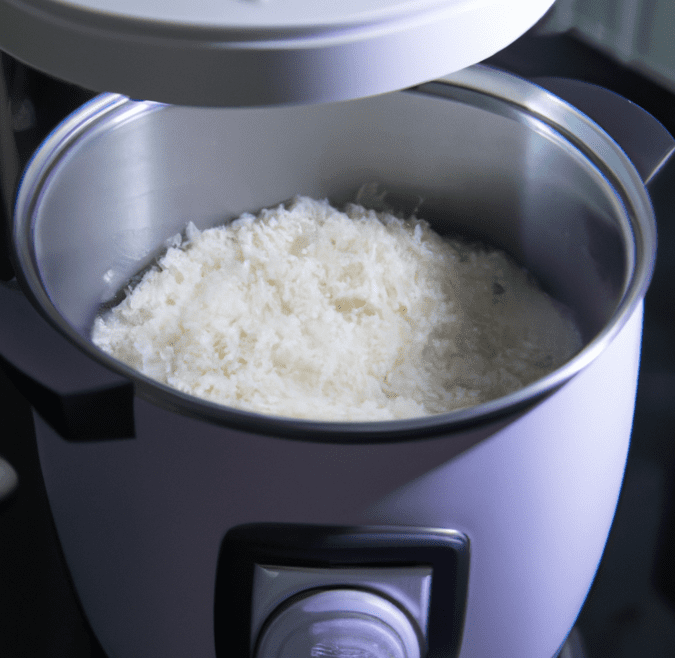Are you tired of juggling multiple kitchen appliances to prepare a simple rice meal? Imagine streamlining your cooking process and saving time and counter space. Enter the electric kettle, a useful and economical kitchen item known for quickly boiling water. But did you know an electric kettle can do more than just boil water? We will look into the question, “Can you cook rice in an electric kettle?” in this post. We’ll look at the practicality, benefits, and downsides of using an electric kettle for rice cooking and offer step-by-step instructions. Let’s get started!
Can You Cook Rice in an Electric Kettle – Exploring the Feasibility:

When cooking rice, most people prefer traditional techniques such as stovetop cooking or using a rice cooker. However, the growing popularity of electric kettles has generated curiosity regarding their capabilities beyond boiling water. The good news is that electric kettles can cook rice, offering a convenient alternative for those seeking efficiency in the kitchen.
Electric kettles’ adaptability as multi-purpose appliances is one of their primary benefits. While their primary role is to heat water rapidly, their design and features frequently allow for longer usage. You may use an electric kettle to cook perfectly cooked rice if you use the appropriate procedures and pay close attention.
It’s important to address the practicality and limitations of using electric kettles for rice cooking. Electric kettles generally have a narrow and tall form optimal for boiling water. This form may provide difficulties in spreading heat throughout the rice. Furthermore, electric kettles frequently lack the particular rice cooking settings found in specialist rice cookers, which may influence the precision of the cooking process.
Cooking rice in an electric kettle may still provide satisfactory results with certain changes and considerations.
Read: can you make ramen in an electric kettle
Step-by-Step Guide to Cooking Rice in an Electric Kettle:
Using an electric kettle to cook rice takes a somewhat different strategy than conventional methods. Following these step-by-step guidelines will increase your chances of getting perfectly cooked rice from your electric kettle:
Weigh the rice:
To begin, use a regular measuring cup to measure the required amount of rice. A conventional serving size is around 12 cups of uncooked rice, which generates approximately one cup of cooked rice.

Rinse the Rice:
Thoroughly rinse the rice under cold water to eliminate extra starch and get fluffier results. Swish the rice gently in a basin or sieve to drain the water. Rep to this procedure until the water is clear.
Modify the Water-to-Rice Ratio:
The water-to-rice ratio varies according to the type of rice and personal preference. A usual starting point is 1:1.5, or 1 cup of rice to 1.5 cups of water. However, follow the recommendations on the rice container or change the ratio to achieve the desired texture.
Fill the Kettle with Water and Rice:
Pour the measured water into the electric kettle, followed by the washed rice. Make sure the rice is uniformly spread and completely submerged in the water.
Start cooking:
Turn on the electric kettle and tightly close the cover. Set the kettle to boil water, then decrease the heat to a low or simmer setting after the water has reached a rolling boil. Because of the reduced heat, the rice will cook gradually and absorb the water.

Check and stir:
Monitor the rice and stir regularly with a spoon or fork to prevent sticking during the cooking time. Avoid scratching the interior of the kettle with metal utensils. To maintain a slow simmer, adjust the heat setting as required.
Check for Doneness:
Check the rice for doneness after about 10-15 minutes. Taste the grains gently with a fork and test them a bit to verify it is cooked to your liking. Cover the kettle and continue cooking for a few minutes if necessary.
Let it Rest:
Once the rice is cooked to perfection, switch off the electric kettle and let it alone for a few minutes with the lid closed. This resting period allows the rice to absorb any leftover moisture and improves its texture.
Serve and Have Fun:
Open the cover, fluff the rice with a fork again, and serve it hot as a side dish or as the foundation for your favorite rice-based recipes.
Remember that the cooking durations and water ratios will vary based on the electric kettle you use and the type of rice you use. Follow the manufacturer’s directions and make the necessary adjustments for the best results.
Read: Is It Safe to Use a Burnt Kettle
Benefits and Drawbacks of Cooking Rice on an Electric Kettle:
Cooking rice in an electric kettle has both advantages and disadvantages. Understanding these considerations will help you decide whether this strategy is appropriate for your requirements. Let’s examine the benefits and drawbacks of cooking rice in an electric kettle.

Benefits:
- Time Efficiency: Electric kettles are well-known for their ability to boil water quickly, which also means rice cooking. With their strong heating components, electric kettles may dramatically shorten the cooking time compared to traditional cooktop techniques.
- Saving Space: For individuals with a small kitchen, boiling rice in an electric kettle is a space-saving alternative. It frees up important counter space because it removes the need for a separate rice cooker or stovetop pot.
- Portability and Versatility: Electric kettles are often lightweight and portable, so they are great for people on the road or those with limited living space. An electric kettle may be a useful companion while traveling, camping, or simply needing a small cooking solution.
Drawbacks:
- Uneven Heat Distribution: Electric kettles are designed to boil water, so they may struggle to spread heat when cooking rice uniformly. As a result, the grains may be unevenly cooked or require further monitoring and stirring.
- Inadequate Precision Settings: Electric kettles frequently lack these exact options, unlike specialized rice cookers, which have multiple settings for different rice varieties. You may need to experiment with water-to-rice ratios and cooking durations to acquire the best results.
- Limited Capacity: Electric kettles usually have a lesser capacity than specialized rice cookers. If you’re cooking a large amount of rice, you may need to divide the batch or experiment with different cooking techniques.
Despite these difficulties, many people have successfully cooked rice in electric kettles by modifying their procedures.
Read:
Exploring Alternative Rice Cooking Methods:
While cooking rice in an electric kettle can be a convenient option, it’s worth exploring alternative methods to understand their pros and cons. Here, we’ll discuss a few popular rice cooking methods and compare them to using an electric kettle:
Stovetop Cooking:
The conventional way of cooking rice is on the stovetop. It involves simmering rice with water until it reaches the desired tenderness. This approach allows for fine control over the cooking process, allowing for temperature and cooking time modifications. However, it needs more active supervision and may take longer than an electric kettle.
Rice Cookers:
Specific rice cookers are intended to cook rice to perfection. They deliver consistent results with various settings for different varieties of rice. Rice cookers sometimes have higher capacity than electric kettles, making them ideal for cooking bigger rice. However, they require dedicated counter space and may not be as versatile as electric kettles.
Instant Pots or Multi-Cookers:
These appliances have grown in popularity due to their capacity to handle a variety of cooking functions, including rice cooking. These products combine the simplicity of electric kettles with rice cookers, allowing you to quickly prepare rice and other foods. Instant pots include preset settings and pressure cooking options, which may cut cooking times dramatically. However, they come with a learning curve and may require experimenting with settings to achieve desired results.
Conclusion:
To summarize, cooking rice in an electric kettle is practical and provides several advantages for those looking for ease and efficiency in the kitchen. While electric kettles are most known for their capacity to swiftly boil water, they may also be used to create perfectly cooked rice.

